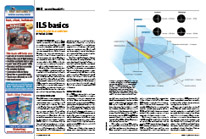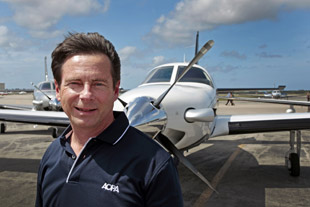Readers weigh in on the assortment of information in our P&E section, which offers technique tips, ownership ideas, and ways to stay proficient.
I completely agree with the article “Keep it Clean: Give Your Aircraft a Bath.” Too many wonderful airplanes sit on the ramp (even in hangars) with weather stains, bugs, and accumulated dirt from uncaring owners who treat their airplanes like cheap lawnmowers. A quick wipe-down after every flight not only helps preserve the airplane’s finish, but also serves as a good postflight inspection.
One word of caution. There are more and more fabric-covered airplanes out there (LSAs, for example) and there is a very important item: Check for and avoid silicon ingredients. Do not use cleaners, soaps, or sprays that contain silicone! Silicone is not paint-shop friendly. If you ever have to make a repair to your aircraft’s fabric, the silicone will have leached into the paint and fabric weave. You don’t see this when you spray it on or apply it, and in fact, it seems to clean just fine. But it is working its way into the very weave of the fabric and deep into the silver coating. This is not as important on aluminum airplanes, as you can sand the paint (and silicon) all the way down to the aluminum (see “P&E: Ownership,” on page 80).
Skip the simple/cheap cleaners items such as Pledge, or some of the car cleaners that have silicon in them. Look for paint-shop friendly cleaners like Flitz to clean your fabric aircraft.
Jon Engle
AOPA 1108508
Hollywood, South Carolina
Hypoxia knockout
I have enjoyed the articles on hypoxia. They are very informative and explain many dangers of low oxygen, but I have not seen anything about the safe oximeter percentage levels we should use.
When I fly my Cirrus cross-country I generally fly between 8,000 feet and 14,000 feet, so we use oxygen a few times a year. When I go above 9,000 feet I monitor my level with my oximeter and when it gets close to 90 percent, we put on the oxygen cannulas and adjust them so our levels are about 90 percent to 92 percent. This level seems to work fine but I don’t know what level we should be using, as I have not found any official information on this. I am 79 years old but in good health. My sea-level reading is about 98 percent.
I would like to suggest you publish an article giving us details on the use of oxygen in small planes and the oximeter percentage levels we should be using. I am sure other pilots would also appreciate the information and confirm if their procedures on the use of oxygen are correct.
Ed McDonald
AOPA 6358216
Miroma Lakes, Florida
See our May issue “P&E: The Air You Breathe” for more information.—Ed.
ILS basics

It is nice to see an informative article on ILS signals in space, as we refer to them.
To meet unrestricted performance, a localizer is required to meet a standard service volume of +/- 10 degrees out to 18 miles and +/- 35 degrees to 10 miles of centerline as depicted. Note that if the IFR procedure requires intercepting the localizer at a distance further out, then the localizer would have to meet an extended service volume or ESV. This ESV is proven usable by FAA Flight Inspection when commissioning the localizer or new or updated procedure. I mention this because at Los Angeles the 25L localizer has to play to 48.5 nm and the ILS on Runway 24 R and L, and Runway 25, have ESVs to in excess of 40 nm. If I remember correctly the localizers at Los Angeles for Runways 24 and 25 have ESVs good to 70 nm.
Also if a localizer fails to have good signals all the way out to +/- 35 degrees of centerline, then flight inspection will issue a notam pronouncin
g the localizer unusable outside of X degrees left or right of course.” Pilots should always check for notams regarding navaid performance, or lack thereof at their intended destination.
Other good practice is always intercept a glideslope from below at the proper altitude and cross-check the GS intercept altitude. Otherwise you may be in for a very steep and fast descent trying to keep up with the needles.
On a glideslope you will have reversed sensing (fly-up indication is actually flying down and vice versa) at 9 degrees, three times the normal glide angle, and a normal glidepath at 15 degrees, or five times the normal glide angle. That is a very steep descent angle for even the best STOL aircraft.
I know of a very experienced charter pilot who, during a checkride under the hood, turned inbound early prior to the lead radial. He had announced “localizer alive” and turned inbound on a false course and began the stepdown descent. The check pilot allowed him to continue until he was about 150 feet above the pine trees on the mountain and then had him take his hood off. Needless to say he was totally surprised that had he done that in IFR conditions—he and his passengers would have died. He did not make that mistake again.
Jim Nulle
AOPA 571084
Foxpark, Wyoming
“Not all Category III ILSs require an autopilot with autoland capabilities. At Horizon Air, a West Coast regional airline, we’ve been hand-flying CAT III approaches using a Head Up Guidance System for more than 20 years. Originally certified in our DHC-8-100s, we are currently flying Q400s to CAT III minimums of 50 feeet DH and 600 RVR. Flight Safety Seattle has two Q400 simulators equipped with HGS; you should go give it a try, it’s easier (and more fun) than it sounds!”
Tom Berning
AOPA 664211
Sandy, Oregon
 “What a fine article by Rod Machado (‘License to Learn: Fewer Feathers’). It tickled a few good memories. In the 1960s, my own Buttercup and I flew low in my old—very old—PT–23. Lack of commentary on the scenery could not be blamed on the low wind as no intercom existed and exhaust from the round engine easily outdid our vocals. In the end, Mr. Rod might agree, it’s really just about having fun.”
“What a fine article by Rod Machado (‘License to Learn: Fewer Feathers’). It tickled a few good memories. In the 1960s, my own Buttercup and I flew low in my old—very old—PT–23. Lack of commentary on the scenery could not be blamed on the low wind as no intercom existed and exhaust from the round engine easily outdid our vocals. In the end, Mr. Rod might agree, it’s really just about having fun.”
Carroll Files
AOPA 7453765
Catonsville, Maryland
Erratum
We wrongly identified the helicopter on our table of contents page as a Bell 407 (April 2015 AOPA Pilot). It is a Bell 206 JetRanger. Thanks to our many readers who caught our mistake. AOPA Pilot regrets the error.
We welcome your comments. Editor, AOPA Pilot, 421 Aviation Way, Frederick, Maryland 21701 or email. Letters may be edited for length and style before publication.
What certificate are you training for now?
Sport 9%
Recreational 1.5%
Private 24%
Commercial 31.5%
Flight Instructor 17%
Airline Transport Pilot 17%
Hangar Talk
 The Piper M600 may be all new-fangled with its Garmin G3000 cockpit, upgraded Pratt & Whitney engine, and supple leather seats, but the rollout of it and its other M Class stablemates was a throwback. “With a glitzy light show, smoke, and big-airplane reveals, I was reminded of airplane unveilings from the 1990s,” says Editor in Chief Tom Haines, who was at the Piper factory in Vero Beach to witness the spectacle (“Best in Class,” page 50). “I was at Piper for the reveal of the Piper Meridian in 1999 and countless others at aircraft companies around the world. Companies pulled out all the stops to impress customers and guests. The biggest bash that I can recall: The rollout of the Israel Aircraft Industries Galaxy in Tel Aviv. What a party! We haven’t seen much of that as companies cut back on such extravagances. It’s nice to see Piper amp up the presentations again. Let’s put away the sackcloth. GA should celebrate our successes more.”
The Piper M600 may be all new-fangled with its Garmin G3000 cockpit, upgraded Pratt & Whitney engine, and supple leather seats, but the rollout of it and its other M Class stablemates was a throwback. “With a glitzy light show, smoke, and big-airplane reveals, I was reminded of airplane unveilings from the 1990s,” says Editor in Chief Tom Haines, who was at the Piper factory in Vero Beach to witness the spectacle (“Best in Class,” page 50). “I was at Piper for the reveal of the Piper Meridian in 1999 and countless others at aircraft companies around the world. Companies pulled out all the stops to impress customers and guests. The biggest bash that I can recall: The rollout of the Israel Aircraft Industries Galaxy in Tel Aviv. What a party! We haven’t seen much of that as companies cut back on such extravagances. It’s nice to see Piper amp up the presentations again. Let’s put away the sackcloth. GA should celebrate our successes more.”


